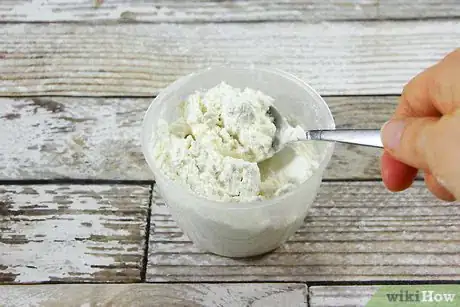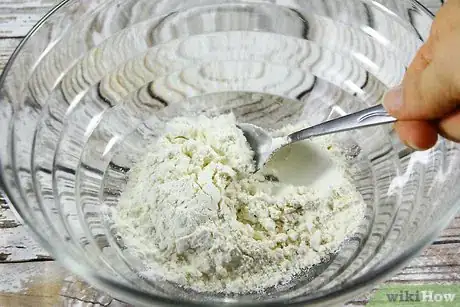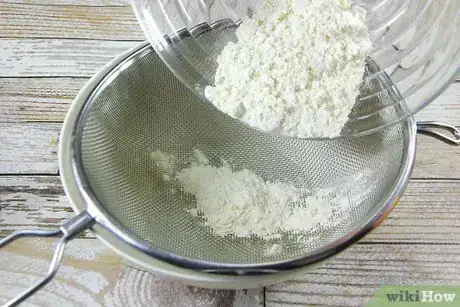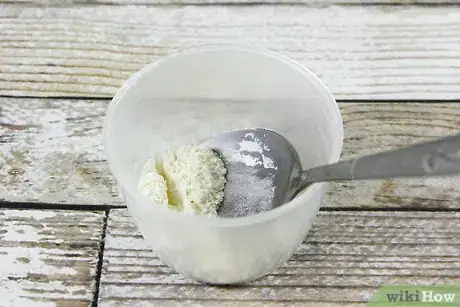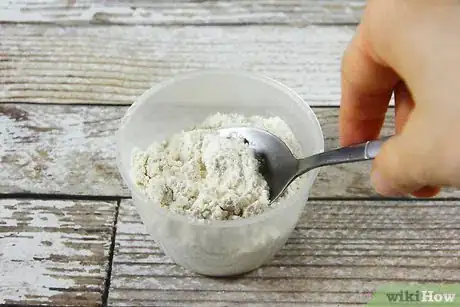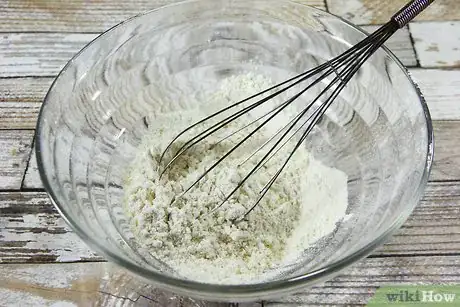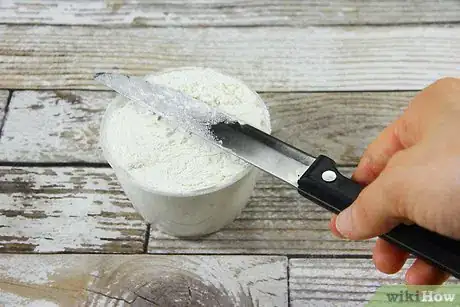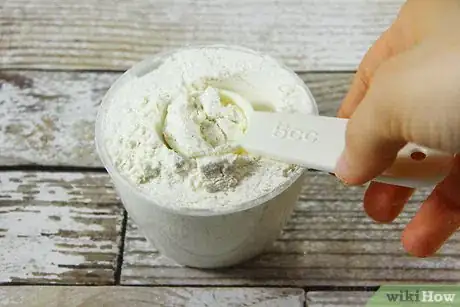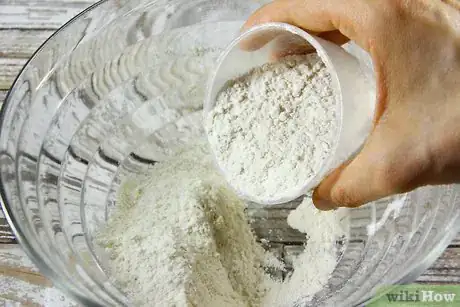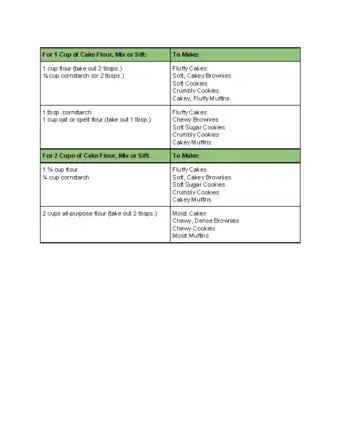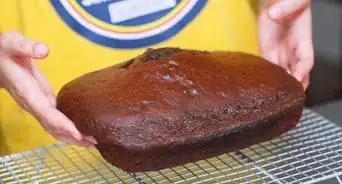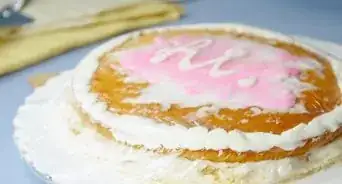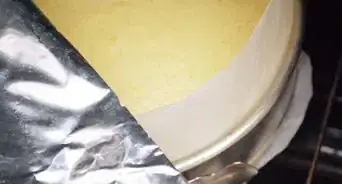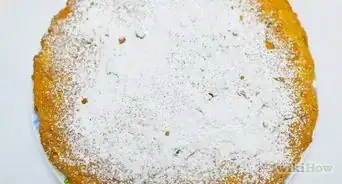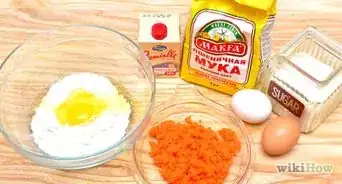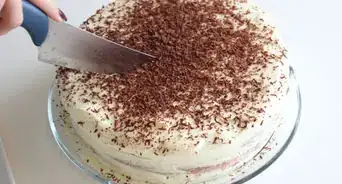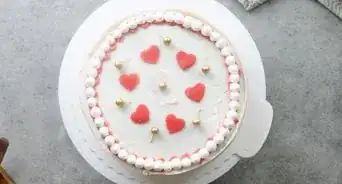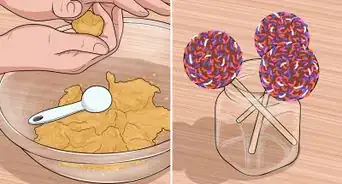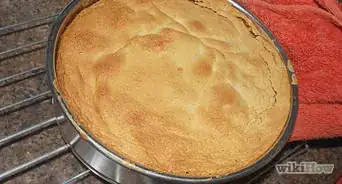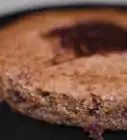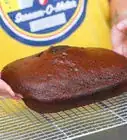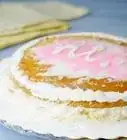This article was co-authored by Maria Short. Maria Short is a Baker and the Owner of Short N Sweet Bakery & Cafe in Hilo, Hawaii. With over 24 years of experience, she specializes in specialty desserts and wedding cakes. She graduated from L’Academie de Cuisine’s Pastry Arts Program with honors and studied at Baltimore International Culinary College. In 2019, Maria competed in the 6th season of the Food Network’s Holiday Baking Championship. In 2010, she had a cake named one of “America’s Most Beautiful Cakes” by Brides magazine.
This article has been viewed 54,968 times.
Cake flour has a lower gluten and protein content, which makes it lighter than all-purpose flour. It adds lightness, structure, and sponginess to delicate baked goods, like cake and scones. You can replicate cake flour's effect by combining regular all-purpose flour with cornstarch, mixing organic cornstarch with oil or spelt flour, or using a smaller amount of all-purpose flour. Making your own cake flour also means it'll be cheaper, more natural, easy to make with common ingredients you're likely to have on hand, and fresher than store-bought flour.
Ingredients
- 2 tbsp (20 g) cornstarch (normal or organic)
- 7/8 cup (130 g) all-purpose flour
- 1 tbsp (10 g) cornstarch (organic) or arrowroot powder
- 7/8 cup (78.75 g) oat, spelt, or white wheat flour
- 7/8 cup (130 g) all-purpose flour
Steps
Using All-Purpose Flour and Cornstarch
-
1Place 2 tbsp (20 g) of cornstarch into a 1 cup measuring cup. To make a cup of cake flour substitute, start with 2 tbsp (20 g) of cornstarch. Measure this ingredient out precisely with a measuring spoon and place the cornstarch in a 1 cup measuring cup.[1]
- The cornstarch will help mimic the lightness of cake flour, which is perfect for light, fluffy cakes that still need structure, such as chiffon or angel food cake.[2]
-
2Fill the rest of the 1 cup (130 g) with all-purpose flour. Use a spoon to transfer flour into the measuring cup, over top of the cornstarch. Keeping adding flour until the 1 cup measurement is full, then level the top off with the flat edge of a knife. This method helps prevent packing and gives you a more precise measurement.[3]
- Avoid the “digging” technique when measuring flour. Digging the cup into a bag of flour can pack extra flour into the measuring cup, which makes the cake denser.
- The main difference between cake flour and all-purpose flour is that all-purpose has more protein, more gluten in it than cake flour. This will work in a pinch, but the texture will still not be quite the same.
Advertisement -
3Combine the flour and cornstarch in a mixing bowl. Dump the measuring cup's contents into a mixing bowl, then use a whisk or spoon to combine the flour and cornstarch. Mix well until the 2 ingredients are combined.
-
4Use another bowl and a strainer or sifter to sift the flour mixture 3-5 times. Place a strainer or sifter on top of another bowl that's about the same size as the first. Pour the flour and cornstarch mixture through, shaking and tapping the sides of the strainer or sifter until the mixture has fully sifted through.[4]
- Sifting will combine and aerate the flour mixture, which will help make the cake light and fluffy.[5]
-
5Scale the 1 cup measurement up and down for the recipe. Use this substitution for 1 cup of cake flour while baking. Scale it as needed, following the amount recommended by the recipe.
- For example, if the recipe calls for 1/2 cup (70 g) of cake flour, use 1/2 (75 g) cup of all-purpose flour and replace 1 tablespoon (14.8 ml) (25 g) of flour with 1 tablespoon (14.8 ml) (10 g) of cornstarch.
Using Oat or Spelt Flour with Cornstarch
-
1Measure 1 tablespoon (14.8 ml) (10 g) organic cornstarch into a 1 cup measuring cup. Cornstarch will give you the best replica of cake flour. Using organic cornstarch will also give you the healthiest option.[6]
- You could also use 1 tablespoon (14.8 ml) of arrowroot powder as an even healthier alternative for organic cornstarch. However, arrowroot is harder to use if you haven't baked with it before, and it changes your cake's texture and cooking time.
-
2Fill up the rest of the 1 cup (78.75 g) with oat or spelt flour. Add spoonfuls of flour to top off the 1 cup, then level it off with the flat side of a knife. Oat and spelt flour are naturally lighter flours, which will help keep the cake fluffy.[7] They're also healthier options—oat flour helps stabilize blood sugar and spelt flour is good for people with gluten sensitivity.
- You can also use white wheat flour, but then you'll need to add another 1 tablespoon (14.8 ml) (10 g) of cornstarch or arrowroot powder. This type of flour will also add a strong wheat flavor to whatever you're baking.[8]
-
3Dump the ingredients into a mixing bowl and whisk them together. Combine the 2 ingredients completely in order to fully aerate the flour.[9]
Using All-Purpose Flour
-
1Measure out 1 cup (150 g) of all-purpose flour. Use a spoon to fill up the measuring cup and the back of a knife to level off the top.
-
2Scoop out 2 tablespoon (29.6 ml) (25 g) of the all-purpose. Use a measuring spoon to carefully remove the 2 tablespoon (29.6 ml) (25 g). The amount will affect the density of the cake, so try not to spill any of the 1 cup (150 g) of flour. Pour the 2 tablespoon (29.6 ml) (25 g) back into the bag of flour.[10]
- Removing 2 tbsp (25 g) from 1 cup (150 g) will leave 7/8 cup (125 g).
-
3Use it as a substitute for 1 cup (140 g) of cake flour. Because cake flour is lighter, you can mimic this effect by using only 7/8 cup (131.25 g) of all-purpose flour as a quick, simple substation for 1 cup (140 g) of cake flour. This technique is especially convenient if you don't have any cornstarch handy.
Sample Substitutions
Things You'll Need
- Cup
- Tablespoon
- Spoon
- Knife
- 2 mixing bowls
- Sifter or strainer
Expert Interview
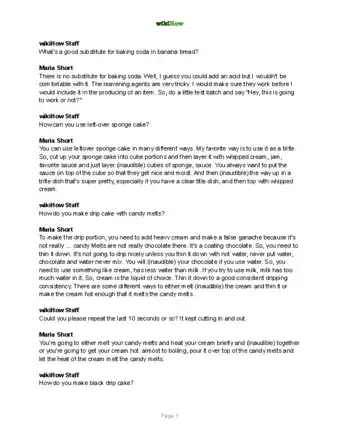
Thanks for reading our article! If you'd like to learn more about cake flour substitutes, check out our in-depth interview with Maria Short.
References
- ↑ https://www.thebalance.com/cake-flour-substitute-recipe-4144356
- ↑ https://www.epicurious.com/ingredients/substitute-flour-all-purpose-cake-self-rising-article
- ↑ https://www.thebalance.com/cake-flour-substitute-recipe-4144356
- ↑ https://youtu.be/_DoBke1g8_k?t=76
- ↑ https://www.epicurious.com/ingredients/substitute-flour-all-purpose-cake-self-rising-article
- ↑ http://www.naturalsweetrecipes.com/healthy-cake-flour-substitute/
- ↑ http://www.naturalsweetrecipes.com/healthy-cake-flour-substitute/
- ↑ http://www.naturalsweetrecipes.com/healthy-cake-flour-substitute/
- ↑ http://www.naturalsweetrecipes.com/healthy-cake-flour-substitute/

